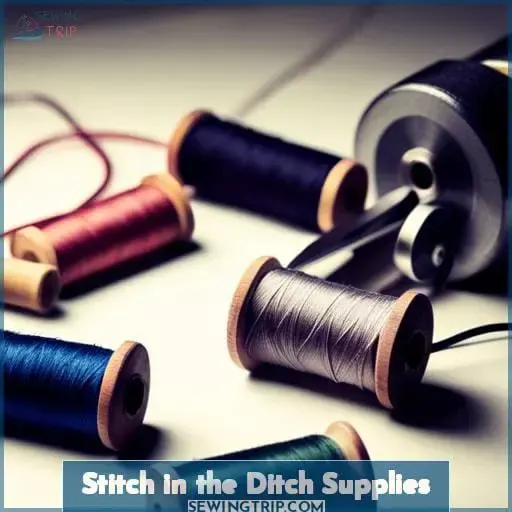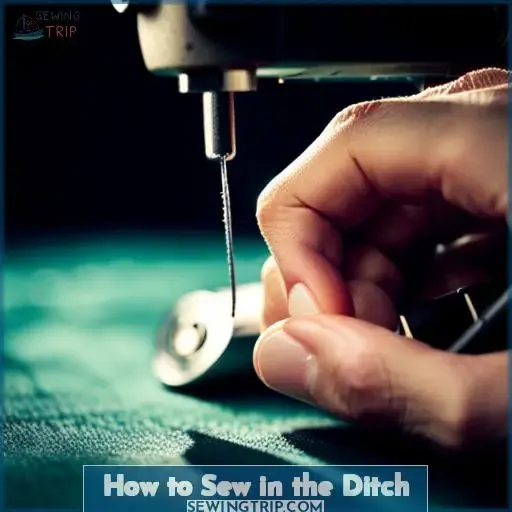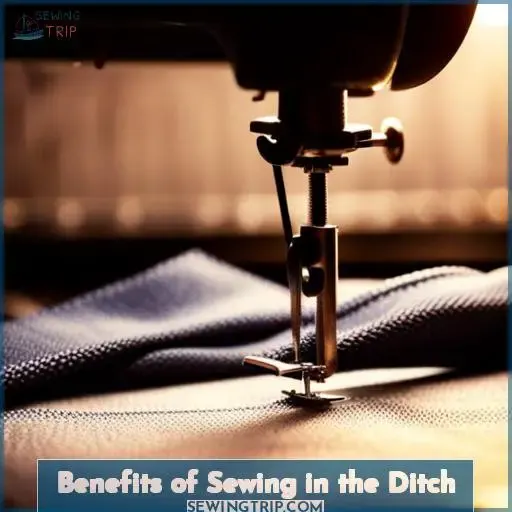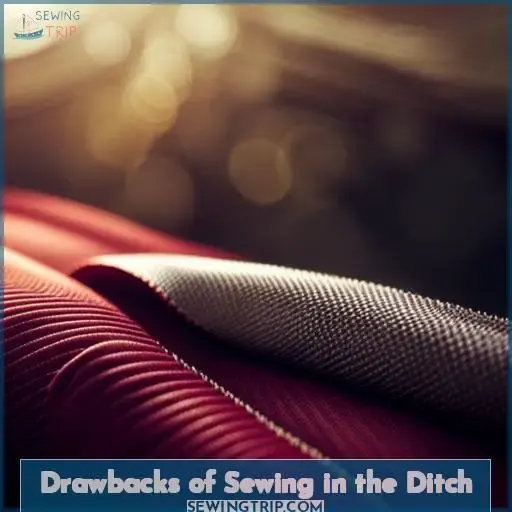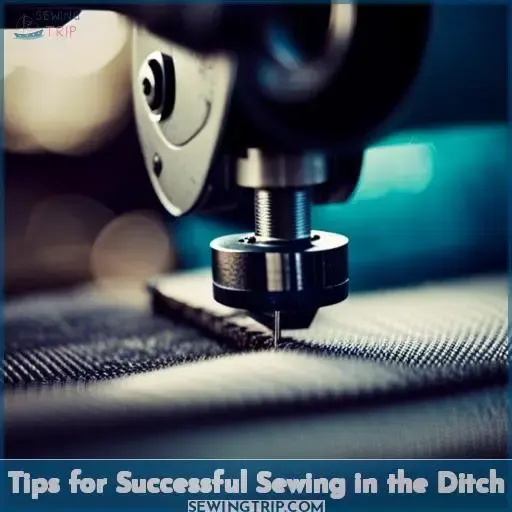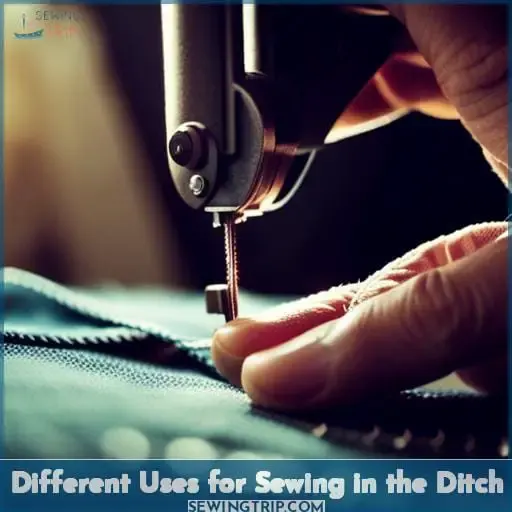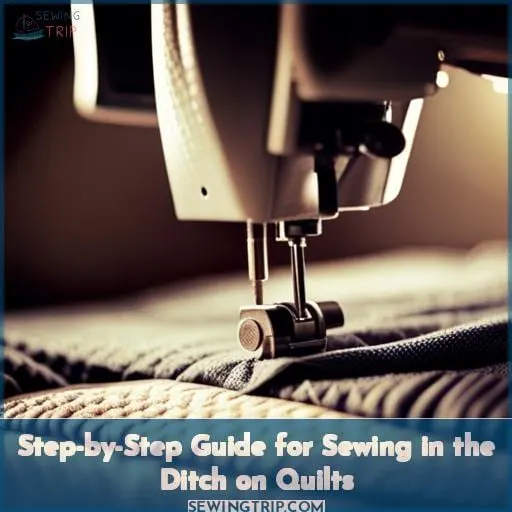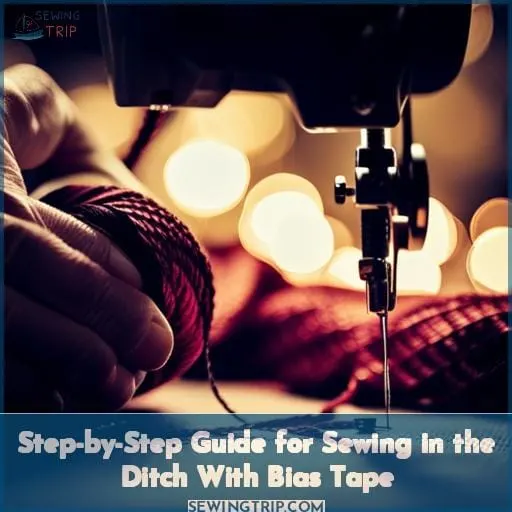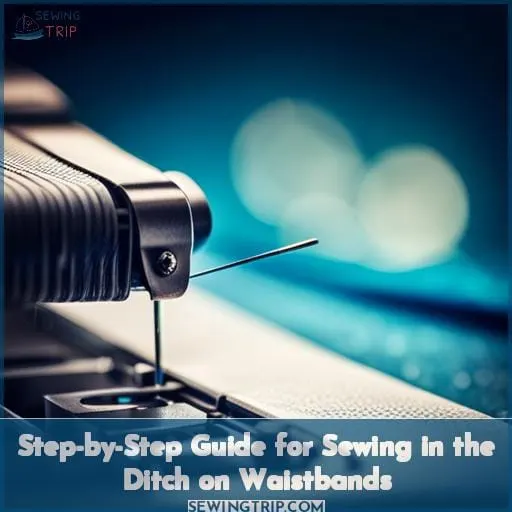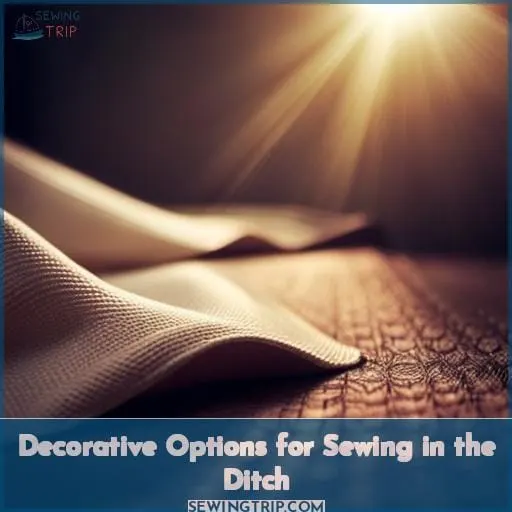This site is supported by our readers. We may earn a commission, at no cost to you, if you purchase through links.
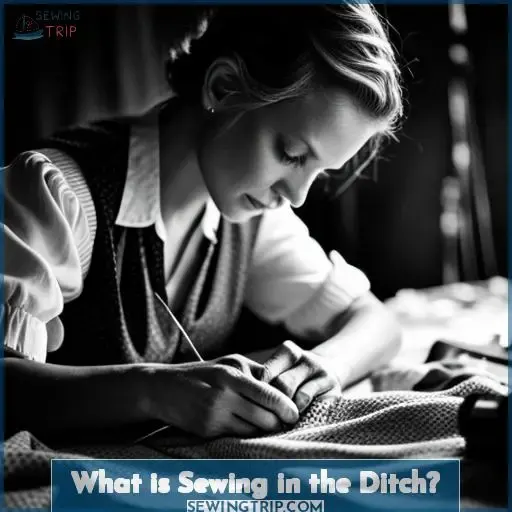 Imagine being able to effortlessly create a seamless finish on your sewing projects, giving them a professional touch that will impress even the most discerning eye.
Imagine being able to effortlessly create a seamless finish on your sewing projects, giving them a professional touch that will impress even the most discerning eye.
Well, my friend, let me introduce you to the art of sewing in the ditch. This technique allows you to discreetly stitch right along those seam lines, creating an invisible line of stitching that blends seamlessly into your fabric.
Get ready to take your sewing skills up a notch and achieve impeccable results with this essential technique.
Table Of Contents
- Key Takeaways
- Stitch in the Ditch Supplies
- How to Sew in the Ditch
- Benefits of Sewing in the Ditch
- Drawbacks of Sewing in the Ditch
- Tips for Successful Sewing in the Ditch
- Different Uses for Sewing in the Ditch
- Step-by-Step Guide for Sewing in the Ditch on Quilts
- Step-by-Step Guide for Sewing in the Ditch With Bias Tape
- Step-by-Step Guide for Sewing in the Ditch on Waistbands
- Decorative Options for Sewing in the Ditch
- Frequently Asked Questions (FAQs)
- Conclusion
Key Takeaways
- Supplies needed: stitch in the ditch foot, matching thread, short stitch length, walking foot
- Benefits: neat and tidy finish, easier to see where to sew, prevents shifting
- Drawbacks: difficulty seeing on dark fabrics, potential needle damage
- Tips for success: use a short stitch length, press seams open and flat, utilize a walking foot
Stitch in the Ditch Supplies
When it comes to stitching in the ditch, having the right supplies can make all the difference.
One essential tool is a stitch in the ditch foot, which helps guide your stitches along the seamline for precise and invisible results.
Additionally, using strong matching color thread ensures that your stitches blend seamlessly into your fabric.
These supplies will help you achieve professional-looking results when sewing in the ditch.
Stitch in the Ditch Foot
To start sewing in the ditch, you’ll need a stitch in the ditch foot as part of your supplies.
This specialized foot is designed to help guide your stitching along the seam lines, ensuring accuracy and precision.
The stitch in the ditch foot can be used with both regular sewing machines and machines equipped with a walking foot for added stability.
Remember to choose a matching thread color for invisible stitches that seamlessly blend into your project’s fabric and create a professional finish.
Stitch in the Ditch Thread
To sew in the ditch, you’ll need strong matching color thread as part of your stitch in the ditch supplies.
Choosing the right thread color is crucial to ensure that your stitches blend seamlessly into the fabric. Opt for a thread that matches your fabric closely to make it virtually invisible.
Additionally, consider using a needle size appropriate for your project and technique, whether it’s machine stitching or hand stitching.
If working with thick batting or multiple layers of fabric in a quilt sandwich, using a walking foot can help prevent uneven stitches and puckering.
How to Sew in the Ditch
Now that you understand what sewing in the ditch is, let’s discuss how to actually sew in the ditch.
There are three key steps to follow:
- Preparing your fabric by pressing and trimming any excess threads or seam allowances.
- Pinning and securing your pieces together along the seam line.
- Finally, sewing directly on top of the seam line using a straight stitch.
By following these steps carefully, you’ll be able to achieve a clean and invisible finish for your garment or project.
Step 1 – Prepare Your Fabric
First, prepare your fabric for sewing in the ditch by ensuring it’s clean and pressed.
To do this:
- Use a pressing foot to press out any wrinkles or creases.
- Hand sew any loose threads or edges to prevent them from getting caught in the stitch.
- Thread a sharp needle with matching thread color.
- Place the right sides of the fabric together and align them carefully.
Now that you have prepared your fabric, you’re ready to move on to Step 2 – Pin and Secure.
Step 2 – Pin and Secure
Pin the fabric pieces together to secure them in place before stitching in the ditch.
- Place your pins strategically along the seam line, ensuring they don’t interfere with your needle or foot.
- Consider pin placement based on stitch length and avoid using pins that are too long, as they may cause distortion.
- Take it slow and steady while pinning to ensure accuracy and prevent shifting.
- To further secure your work, use a backstitch at both ends of the seam line.
Step 3 – Sew in the Ditch
Once you have pinned and secured your fabric, it’s time to sew in the ditch.
To achieve invisible stitches, you can use either a machine or hand stitching technique.
If using a machine, consider using a walking foot or quilting foot for better control and accuracy.
Sew along the quilting lines or seamlines of your garment to create an invisible stitch that secures the fabric pieces together seamlessly.
Benefits of Sewing in the Ditch
When it comes to sewing in the ditch, there are several benefits that make it a worthwhile technique to master.
Firstly, stitching in the ditch creates a neat and tidy finish on both the front and back of your garment or project.
Secondly, by following along the existing seamline, it becomes much easier to see where you need to sew, ensuring accurate results every time.
Lastly, sewing in the ditch helps prevent shifting of fabric layers during construction or quilting, resulting in more professional-looking finished pieces.
Neat and Tidy Finish
To achieve a neat and tidy finish on your project, sewing in the ditch offers a great solution. It allows you to secure seams without visible stitches, creating an invisible and professional-looking result.
This technique is especially useful when working with difficult fabrics or when you want to maintain the integrity of a visible seam.
Using a walking foot can further enhance the precise stitching for that perfect finishing touch.
Easier to See Where to Sew
One benefit of sewing in the ditch is that it makes it easier for you to see where you need to sew.
This technique is especially helpful when working with thin fabrics or intricate designs.
By stitching along the existing seam line, you can ensure that your stitches are visible and precise.
Whether you’re securing facings on garments, attaching cuffs or waistbands, or quilting square blocks, sewing in the ditch allows for better visibility and accuracy in your stitching.
Prevents Shifting
To prevent shifting, sew in the ditch using a walking foot.
Sewing in the ditch keeps seams flat and prevents them from shifting during sewing or quilting. This technique ensures that your stitches stay exactly where they should be, preventing any puckering or bulkiness in your project.
By securing the fabric layers together along existing seam lines, you can achieve smooth and wavy-edge-free results every time.
Drawbacks of Sewing in the Ditch
When sewing in the ditch, one of the drawbacks you may encounter is difficulty seeing on dark fabrics.
The stitches can blend into the fabric, making it challenging to follow the seam line accurately.
Additionally, there’s a risk of needle damage when stitching in close proximity to the threads holding your pieces together.
It’s important to take extra care and sew slowly to avoid hitting these threads and potentially damaging your garment or project.
Difficulty Seeing on Dark Fabrics
Sewing in the ditch can become more challenging when working with dark fabrics due to the difficulty in seeing the seam lines.
The dark fabric can make it hard to distinguish where exactly you need to sew, resulting in uneven stitching or even missing the ditch altogether.
To overcome this issue, there are a few techniques you can try.
Using a light-colored thread will create contrast and help you see your stitches better.
Additionally, using a walking foot and a shorter stitch length will provide stability and precision while sewing on dark fabrics.
If needed, using a magnifying glass can also assist in improving visibility during sewing tasks on darker materials.
Potential Needle Damage
If you’re not careful, sewing in the ditch can potentially cause damage to your quilt due to the needle hitting the threads holding the pieces together.
To avoid this, make sure you’re using a machine with a right-sized needle that won’t pierce through multiple layers of fabric and quilting threads.
Additionally, take care when stitching close to other seams or stitches in order to avoid hitting them with your needle.
If you prefer hand stitching, be mindful of where your needle is going and ensure it doesn’t accidentally hit other threads while sewing in the ditch.
By taking these precautions, you can prevent any potential damage from occurring during this technique.
Tips for Successful Sewing in the Ditch
To achieve successful sewing in the ditch, there are a few key tips to keep in mind.
First, use a short stitch length, around 1.5 mm, to ensure that your stitches are secure and invisible.
Second, press your seams open and flat before sewing in the ditch to create smooth lines.
Lastly, utilize a walking foot on your machine to help guide the fabric smoothly through for precise stitching along the seamlines.
Following these tips will ensure clean and professional results when sewing in the ditch.
Use a Short Stitch Length
By using a short stitch length, you’ll ensure successful sewing in the ditch. Here are four reasons why it’s important:
- Prevents Needle Damage: Sewing too far from your seam line increases the risk of your needle hitting and potentially damaging delicate threads holding your pieces together.
- Prevents Shifting: When you use longer stitches while stitching in-the-ditch along seams or edges on garments or quilts items like tote bags, pillowcases, etc., there’s an increased chance that those fabrics will shift as they’re being stitched down leading not only messier results but also less secure attachments overall which might lead unraveling over time!
- Easier to See: A shorter stitch length makes it easier to see exactly where you need to sew within those ditches- particularly helpful when working with darker colored materials! So if visibility has been an issue before, don’t worry because now even small details won’t be forgotten thanks these tighter settings allowing better accuracy throughout every step along way. Just remember to always start off slow, keep eyes focused directly upon area under foot making sure everything aligned properly before continuing forward.
- Neat And Tidy Finish : With smaller stiches ,you get precise lines giving you neater and more professional finish. It’s a great way to ensure that your stitches are tight, secure, and won’t come undone easily.
So next time you’re stitching in the ditch, remember to adjust your stitch length settings accordingly for better results. Whether it’s securing a waistband or quilting a patchwork design, using a shorter stitch length will help prevent needle damage while creating neat and tidy finishes with tight stitches that can withstand the test of time.
Press Seams Open and Flat
To achieve successful sewing in the ditch, press your seams open and flat. This step is crucial to ensure a clean and professional finish.
By pressing the seams open, you can avoid puckering and prevent tunneling, which can mar the appearance of your garment or quilt.
Additionally, using a walking foot along with a sharp needle will further help you achieve smooth stitching without breaking threads.
Pressing is key to mastering this technique!
Utilize a Walking Foot
To achieve successful sewing in the ditch, utilize a walking foot.
This essential tool prevents shifting and tunneling of fabrics, keeping your quilt flat and your fabric moving smoothly.
The walking foot also helps prevent puckering by evenly distributing the pressure from the feed dogs on both layers of fabric.
It’s a must-have for achieving professional-looking stitches when sewing in the ditch.
Different Uses for Sewing in the Ditch
When it comes to sewing in the ditch, there are various uses for this technique.
One common use is securing facings on garments, which helps to keep them in place and hidden from view.
Additionally, sewing in the ditch can be used to attach cuffs or waistbands, providing a clean and professional finish.
Lastly, stitching in the ditch is often employed as a method of finishing quilts by neatly securing layers together along seam lines.
Securing Facings on Garments
When sewing in the ditch, you can also use this technique to secure facings on garments without visible stitches.
Here are some tips and uses for securing facings using stitching in the ditch:
- Use a matching thread color to make your stitching invisible.
- Pin through the seam line to hold the facing in place.
- Sew from the right side of the garment for better visibility.
- Pull gently on fabric as you sew to keep it flat and prevent ridges.
- Mistakes are okay – a few stitches outside of the seam line won’t be noticeable.
Remember these tips when using hand or machine stitching techniques.
Attaching Cuffs or Waistbands
Attach cuffs or waistbands by stitching in the ditch to secure them in place without visible stitches on the outside.
This technique is especially useful when working with lightweight fabrics or curved seams.
To achieve an invisible finish, use a matching thread color and topstitch close to the seamline.
You can also choose to hand sew for more control and precision.
Try this method for a professional-looking result every time!
Finishing Quilts
For finishing quilts, you can achieve a neat and professional look by sewing in the ditch.
Whether you prefer hand sewing or using a machine, this technique allows you to create invisible stitches that secure your quilt layers together.
By stitching along the seam lines and attaching batting between patchwork pieces, you can complete your quilt with a beautiful binding around the edges for added durability and aesthetics.
Step-by-Step Guide for Sewing in the Ditch on Quilts
Let’s dive into the step-by-step guide for sewing in the ditch on quilts.
First, you’ll need to join your patchwork pieces together using a 1/4 inch seam allowance.
Next, layer your batting between the pieced top and backing fabric.
Then, change to a stitch-in-the-ditch foot on your sewing machine and stitch along each seam line to secure all layers together.
Finally, complete your quilt by finishing with binding around the edges for a polished look.
Additional information:
- Stitching in the ditch is commonly used in quilting as it helps secure layers of fabric without visible stitches.
- This technique creates an invisible finish on both sides of the quilt.
- Sewing accurately along each seam line ensures that all layers are securely held together during use and washing.
- By following this step-by-step guide, you’ll achieve professional-looking results while maintaining durability and longevity in your quilted projects.
Joining Patchwork
To achieve a seamless finish on your quilt, mastering the technique of joining patchwork through sewing in the ditch is essential.
By hand or machine, align the seams and stitch along them for a secure bond that remains invisible on the front of your quilt.
Layering Batting
Now that you have joined your patchwork pieces together, it’s time to move on to the next step in sewing in the ditch: layering batting.
- Choose a suitable batting type and thickness for your quilt.
- Place the batting evenly between the pieced top and backing fabric.
- Secure the layers together with pins or a temporary adhesive spray before stitching.
Layering batting is an essential part of quilting as it adds warmth, loft, and dimension to your finished project. The choice of batting depends on personal preference and desired outcome. Consider factors such as thickness, type (cotton, polyester), weight (lightweight or heavyweight), and placement within your quilt sandwich.
To begin layering the batting:
Changing Foot and Stitching
To continue quilting in the ditch, change to a stitch-in-the-ditch foot and adjust your machine settings accordingly.
This specialized foot helps guide the needle along the seamline for precise stitching.
Consider using a smaller needle size for accuracy and choose an appropriate foot based on batting thickness and fabric weight.
If desired, you can also opt for hand stitching to achieve a more delicate finish.
Finishing With Binding
Once you have finished joining the patchwork and layering the batting on your quilt, it’s time to change your foot and stitch in the ditch to secure everything in place.
Here’s how:
- Prepare your binding strips.
- Attach one side of the binding to the front of the quilt, aligning raw edges.
- Fold over and press seam allowances towards back of quilt.
- Stitch in the ditch along folded edge, catching corners for a clean finish with minimal visible stitching.
Step-by-Step Guide for Sewing in the Ditch With Bias Tape
Now, let’s dive into the step-by-step process for sewing in the ditch with bias tape.
First, you’ll need to prepare your bias tape by folding and pressing it correctly.
Then, you’ll stitch and clip the bias tape onto your fabric piece.
After that, press the bias tape towards the back of your fabric and secure it with a final round of stitching.
Lastly, give everything a good press to ensure a professional finish on your project.
Preparing Bias Tape
To prepare bias tape for sewing in the ditch, cut and fold fabric at a 45-degree angle.
Cut bias strips to desired width.
Press bias tape in half, wrong sides together.
Fold raw edges towards center crease and press again.
You’re now ready to attach the bias tape using the sewing-in-the-ditch technique!
Stitching and Clipping
To stitch and clip while sewing in the ditch with bias tape, follow this step-by-step guide:
- Start by stitching along the seamline.
- Clip the seam allowances, corners, threads, curves, and bias tape.
This will ensure a clean finish and secure your fabric pieces in place.
Pressing Bias to Back
First, gently press the bias tape to the back of your fabric.
- Use a pressing tool like an iron or a steam press to ensure a crisp and flat finish.
- Follow proper pressing technique by applying even pressure and moving in one direction.
- Pressing order is important – start from the center and work towards the edges.
- Utilize a pressing foot on your sewing machine for precise and controlled results.
Final Stitching and Pressing
Now stitch the bias tape securely in place with a final round of stitching using your sewing machine.
Make sure to backstitch at the beginning and end for added durability.
Press the seams open to create a smooth finish, and admire your invisible stitches that hold everything together beautifully.
Step-by-Step Guide for Sewing in the Ditch on Waistbands
Now it’s time to focus on sewing in the ditch on waistbands.
This technique is commonly used to secure the waistband in place without visible stitches on the outside of the garment.
The process involves stitching along the seam line, pressing, folding, and then completing a final stitch for a clean and professional finish.
Stitching the Waistband
Now, let’s move on to stitching the waistband.
To create an invisible finish, use a walking foot and matching thread.
Securely stitch along the seamline of your waistband, ensuring it’s nice and flat.
For added flair, consider using a decorative stitch for extra detail.
Pressing
To press the waistband, start by using an iron to smooth out any wrinkles and create a crisp finish.
- Set your iron to the appropriate temperature for your fabric.
- Place a pressing cloth over the waistband to protect it from direct heat.
- Gently glide the iron over the surface of the waistband, applying even pressure.
- Pay special attention to any curved or folded areas, ensuring they lay flat and smooth.
Folding and Pressing
Fold the waistband in half lengthwise and press it with an iron. This will create a crisp fold and make it easier to sew in the ditch.
Pressing seams open or flat is important for achieving professional-looking results. Take your time to ensure that all seams are pressed accurately and smoothly before moving on to the next step of sewing in the ditch on waistbands.
Final Stitching
Once you have pressed the waistband in place, it’s time to stitch it down securely using a sewing machine.
Set your machine to a straight stitch and attach a walking foot for even feeding.
Sew along the ditch, making sure your stitches are visible but blend into the fabric seamlessly.
Decorative Options for Sewing in the Ditch
Now that you have mastered the technique of sewing in the ditch, it’s time to explore some decorative options.
One option is to use a decorative stitch on your machine, such as a zigzag or an embroidery stitch, to add visual interest along the seamline.
Another option is to embellish the seam with trimmings like lace or ribbon for an extra touch of elegance.
Get creative and experiment with different techniques to make your stitched-in-the-ditch seams truly stand out!
Using a Decorative Stitch
After you have successfully stitched in the ditch, add an extra touch of creativity to your project by using a decorative stitch.
Whether you prefer hand sewing or machine sewing, there are various options for incorporating decorative stitches into your work.
Machine sewers can explore different types of decorative stitches available on their machines, while hand sewers can experiment with embroidery techniques and fancy stitching patterns.
For added visual interest and texture, consider using a twin needle for creating unique designs.
To further enhance your decorative stitchwork, try adding embellishments such as beads or sequins for that extra wow factor!
Adding Embellishments
To enhance stitching in the ditch further,
don’t hesitate adding some exquisite touches such as delicate beadwork or detailed embroidery.
These wonderful decorative options have a way of making your garments truly stand out.
When selecting embellishments, take into account the types, sizes, and placements to achieve desired effects.
Color plays an important role too; choose hues that complement or contrast with your fabric.
Materials like beads offer versatility—varying from glass pearls to up-cycled elements.
Improve your skills in beading techniques and experiment with different styles and combinations for stunning results.
Adding these embellishments to your projects will surely unleash your creativity, power, and mastery over sewing.
Frequently Asked Questions (FAQs)
What are some common mistakes to avoid when sewing in the ditch?
When sewing in the ditch, avoid stitching outside of the seam line. Nobody will notice a few accidental stitches.
Take your time and focus on keeping your stitches hidden in the groove for a flawless finish.
Can sewing in the ditch be done by hand, or is it best done with a sewing machine?
Sewing in the ditch can be done by hand or with a sewing machine.
By hand, use a running stitch and longer quilting needle for thicker fabrics.
With a machine, use short stitches and a walking foot for smooth movement.
Are there any specific fabrics or materials that are more difficult to sew in the ditch?
When it comes to sewing in the ditch, certain fabrics can be trickier than others.
Fabrics with a lot of texture or thickness may make it harder to see and stitch accurately in the seamlines.
How do you know when to use a walking foot versus a regular presser foot for sewing in the ditch?
When sewing in the ditch, use a walking foot for:
- Thicker fabrics
- When you need extra control
A regular presser foot is suitable for:
- Lighter fabrics
- Simpler projects
Choose based on your fabric and desired outcome.
Are there any alternative techniques or stitches that can be used instead of sewing in the ditch for securing pieces of a garment?
When it comes to securing pieces of a garment, sewing in the ditch is a tried and true method.
- Edge stitching
- Topstitching
Conclusion
To sum it up, sewing in the ditch is a valuable technique that can elevate your sewing projects to a professional level.
With the right supplies and a few simple steps, you can achieve a seamless finish that will impress even the most discerning eye.
Whether you’re working on garments, quilts, or other sewing projects, sewing in the ditch offers a neat and tidy finish, prevents shifting, and allows for easier sewing.
So, give it a try and take your sewing skills to the next level!

